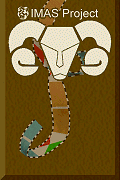Pastoralism, or extensive livestock herding, is the most prevalent form of land use in East Africa in terms of land area used. These pastoral regions also support some of the largest and most viable wildlife populations in Africa. Traditional pastoral livestock production has been highly compatible with wildlife conservation, but this compatible interaction is showing signs of disintegration in may parts of East Africa. Livestock and wildlife area viewed as competitors for limited forage. Livestock are seen as spreading disease into wildlife, and wildlife are seen as spreading disease into livestock. Spatial components of pastoral ecosystems have been disrupted by competing forms of land use, with negative implications for ecosystem persistence.
We are developing an integrated modeling and assessment system (IMAS) that integrates computer modeling, geographic information systems, remote sensing, and field studies to provide the information and understanding necessary to conserve biodiversity, wildlife, and ecosystem integrity while increasing pastoral food security. The IMAS is based upon an existing spatial-dynamic ecosystem model called Savanna. The IMAS quantifies the impacts of land tenure, enterpise scale, and conservation policy on four objective functions: livestock production, pastoral welfare, wildlife, and ecosystem integrity. The system will enable alternative policy and management strategies to be objectively explored, debated, implemented, and reassessed. The IMAS is being implemented at Ngorongoro Conservation Area, Tanzania; Kajiado District, Kenya; and Lake Mburo National Park, Uganda. Regional analyses are being conducted to identify areas of high and low conflicts between pastoralists and wildlife, the economic costs of conflicts and the benefits of their solutions, and appropriate policies for mitigating and preventing unfavorable pastoral-wildlife interactions in an era of rapid land use changes, human population growth, and modernization.
The results of ecological changes or developmental innovations are felt primarily and most directly at the household level, in terms of changes in income, food security, and nutritional status. Impacts also have to be assessed at the community and regional levels, because land-use and other decisions are often made at these levels as well as at the individual household level. A human ecology and economics component of the IMAS is being developed to address processes at the household level.
A GIS-based disease submodel is being developed and will ultimately be linked to Savanna. Employing a linked disease-Savanna model, we will predict the health consequences of alternative livestock and wildlife management strategies and disease control measures, and the relative trade-offs in terms of disease risk versus loss of forage and animal productivity. Existing information for each of three diseases will evaluated to identify parameters for which data exist and those for which assumptions and estimates must be made.
Site-level studies are being conducted to assess changes in vegetation composition and abundance, and to develop a response database for ecological responses to resource use. Changes in herbaceous layer production and species composition are being studied in response to climate, grazing, fire, and soils.
A regional level component of the IMAS will be based upon GIS analyses. Cross-site comparisons are to be conducted among the study sites in 3 or 4 countries. More immediately, we are scaling-up to the region based upon our understanding of the varied situations in different countries and physical environments, and the distributions of such environments across the region. We are developing a regional-scale modeling initiative that will be designed to address broad-scale gradients and differences. Regional-scale GIS modeling will be used to identify areas of high and low conflicts between pastoralists and wildlife, in relation to policies that may be causes of, or which aim to resolve, such conflicts.
Studies are being conducted to determine the policy environment at both the local and regional levels, to determine how the IMAS approach might be most effectively used to effect change.
See our projects pages to learn more about the components of IMAS.


